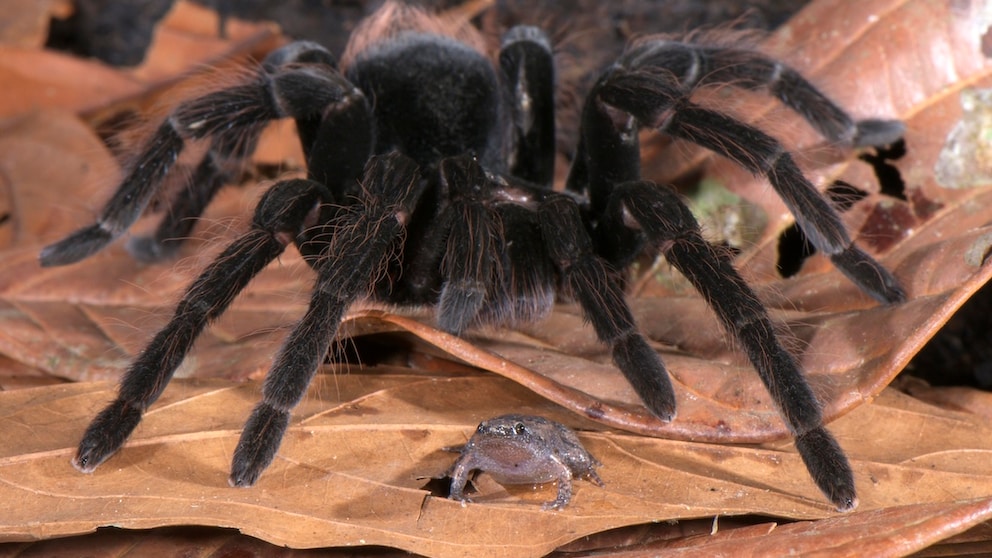April 8, 2025, 1:17 pm | Read time: 4 minutes
A frog and a tarantula share a cave — without one eating the other? It sounds like a fable, but in South America and Asia, this is a reality. Why these very different animals form a living community is an astonishing natural phenomenon with mutual benefits.
They share burrows and appear to tolerate — and even protect — each other. In Sri Lanka, Paraguay, and Peru, researchers have documented a close relationship between ground-dwelling frogs and giant tarantulas. These unlikely living communities raise the question of whether they represent mere coexistence or genuine mutualism — a symbiotic relationship that benefits both species.
Tarantulas and Frogs Actually Fall into the Predator-Prey Spectrum
Symbiosis — the coexistence of different species — can take many forms. While in parasitism, only one side benefits and the other is harmed, mutualism is characterized by mutual benefit. Such relationships are particularly fascinating when they occur between groups of animals that are normally in a predator-prey relationship — such as spiders and frogs.
In tropical habitats, ground-dwelling and tree-dwelling amphibians and spiders regularly encounter each other. However, instead of competition or attack, in some cases, silent cooperation seems to be established, the advantages of which are only partially understood so far.
Researchers observed a remarkable partnership of this kind between the Sri Lankan bullfrog (Kaloula taprobanica) and the ornamental tarantula Poecilotheria fasciata. A similar phenomenon was described in the Peruvian rainforest in 1989, where the small narrow-mouthed frog Chiasmocleis ventrimaculata cohabited with the theraphosid spider Xenesthis immanis.
Most recently, in 2021, this phenomenon was also documented in Paraguay between the tarantula Eupalaestrus campestratus, also known as the ‘pink zebra beauty,’ and another narrow-mouthed frog (Chiasmocleis albopunctata).
Tarantulas Protect “Their” Frogs
But what are the actual benefits these very different species derive from living together? In Sri Lanka, an unusual coexistence was documented in tree hollows as part of a conservation project. There, tarantulas and frogs not only shared a habitat but also displayed conspicuous behavior. When the frog was uncovered by the researchers, the spider jumped onto its back — without any signs of aggression. The authors interpreted this as protective behavior, suggesting that the relationship be classified as mutualism.1
Researchers had already observed a similar community in Peru in 1989. Over a period of three months, they followed the nocturnal activities of frogs and spiders in shared burrows. Here, too, frogs were not eaten — even when the spiders were actively hunting other frog species. The authors attributed this to chemical protective substances in the frogs’ skin and classified the relationship as commensalism—a form of symbiosis where one organism benefits without harming the other.2
Frog Protects Spider Eggs
The phenomenon was also recently observed in Paraguay. Several frogs even lived together with a spider in each of the two burrows. The spiders showed no aggression during physical contact. However, this revealed another component of the behavior. The frogs feed on ants and protect the spider eggs from being eaten by these animals.
The spider, in turn, could offer the frog protection from predators such as snakes or geckos through its presence. As with the study in Sri Lanka, the researchers assume a symbiosis that is beneficial for both (mutualism). They also believe that the frogs deliberately seek shelter in the spiders’ burrows — presumably also because of the stable microclimate in the burrow. 3

Study Clownfish Actively Supply Their Anemone with Food

Toxic Love Blue-Striped Octopuses Poison Partners to Prevent Them from Being Eaten During Sex

Fatal Within Minutes The Most Poisonous Animals in the World
Three Studies — a Global Pattern?
The prevailing hypothesis is that certain micro frogs are recognized by spiders based on chemical signals and are thus classified as ‘inedible.’ At the same time, these frogs consume ants, which are considered the main threat to spider eggs. For the frogs, living together with a predator offers protection from others — such as snakes or birds. Spiders, in turn, benefit from nest protection and perhaps reduced egg predator density.
However, these frog-spider communities also raise exciting questions: Are they an isolated case or more widespread than previously assumed? How do spiders recognize “their” frogs? What role does the amphibians’ diet play in their chemical defenses? Moreover, could such interactions be an underestimated factor for the survival of both species in disturbed habitats?
All three studies show that such relationships develop independently on different continents, with different species — an indication of convergent evolution. They also serve as an impressive example of our limited understanding of the hidden dynamics within tropical ecosystems.

